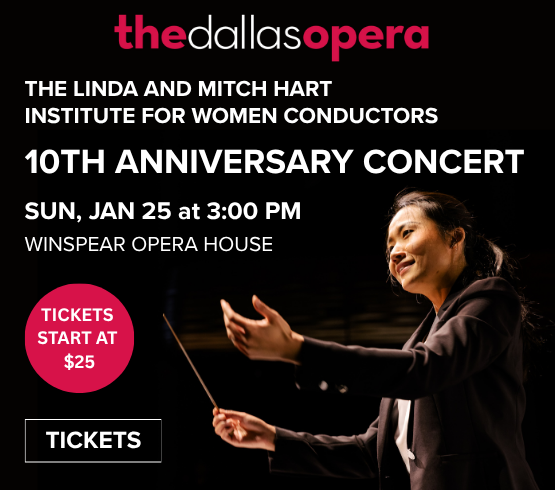A conversation with Mario Aschauer, Founder and Artistic Director of Harmonia Stellarum Houston (HSH), often involves plunging down rabbit holes and winding through meandering paths before the subject emerges with newfound depth and clarity.
This summer, Aschauer visited the workshop of Gerard Tuinman, a respected fortepiano builder and restorer based in Utrecht (Netherlands), to check on the progress of a historical fortepiano he is building for HSH. “Gerard’s craftsmanship is simply stunning,” says Aschauer.
Modelled after the instruments made by Johann Andreas Stein, famous for his design of the revolutionary German hammer action, the exquisite walnut case of this fortepiano houses two separate actions. Here Aschauer dives into the history of the invention of the piano and the various experimentations in hammer action between the 1860s and 1890s. “Stein worked at a time when the hammerhead question wasn’t decided yet,” explains Aschauer. “It was really a moment of experimentation. Shapes and materials varied, anywhere between a hollow, bare wooden tube, to one with felt or leather, to solid wood with felt or leather.”
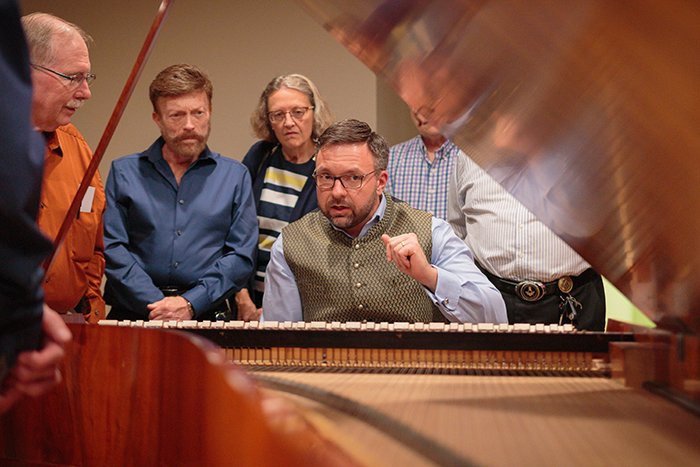
1 ⁄7
Artistic Director Mario Aschauer demonstrating a fortepiano to patrons. Photo by Carlo Resti Ruano.
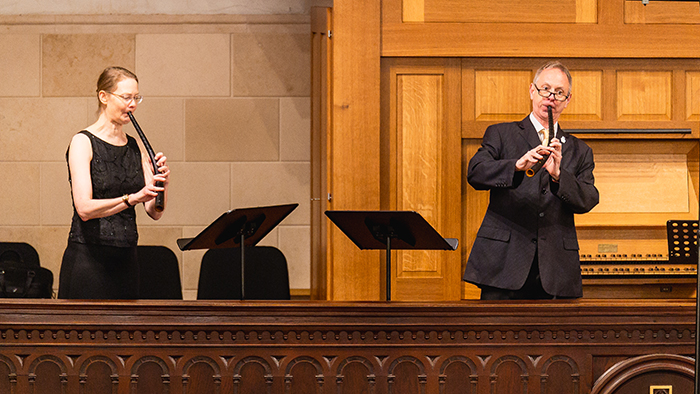
2 ⁄7
Kiri Tollaksen and Doron Sherwin playing cornetto, a hybrid between trumpet and woodwind instrument popular in the 16th and 17th centuries. Photo by Babacar Faye.
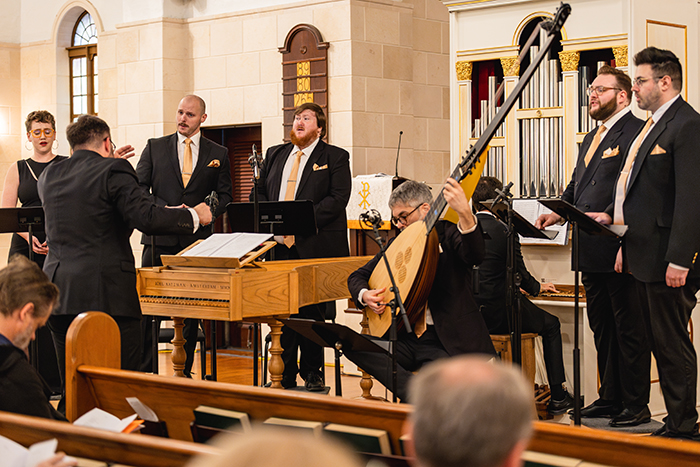
3 ⁄7
Harmonia Stellarum performing Claudio Monteveri’s Sixth Book of Madrigals with Dan Swenberg playing theorbo. Photo by Carlo Resti Ruano.
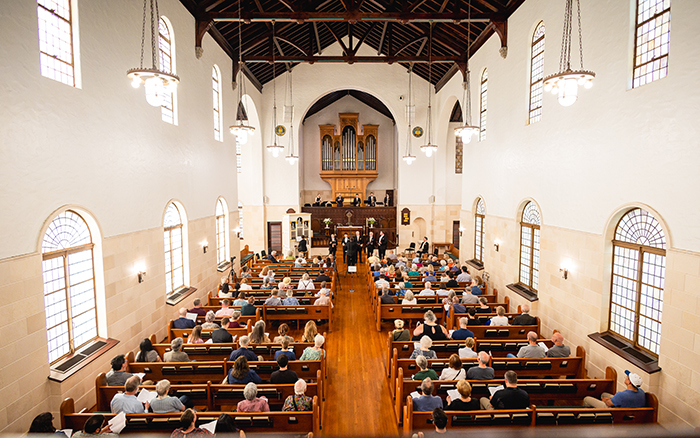
4 ⁄7
Harmonia Stellarum performing polychoral music by Heinrich Schütz in the exquisite acoustics of First Lutheran in Houston, a Texas Historic Landmark. Photo by Babacar Faye.
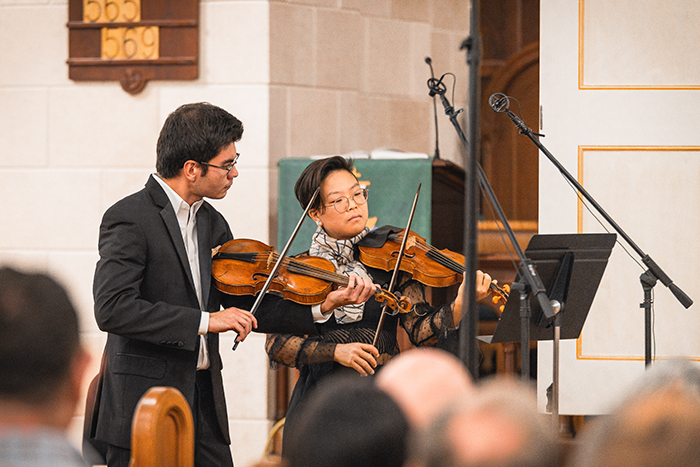
5 ⁄7
Tsutomu William Copeland and concertmaster Manami Mizumoto playing violin the 17th-century way. Photo by Carlo Resti Ruano.
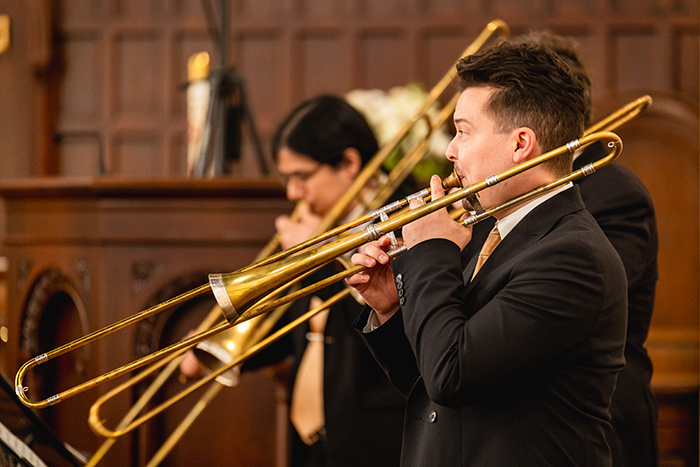
6/7
Harmonia Stellarum’s trio of sackbuts: Henry van Engen, Ben David Aronson, BJ Hernandez. Photo by Carlo Resti Ruano.
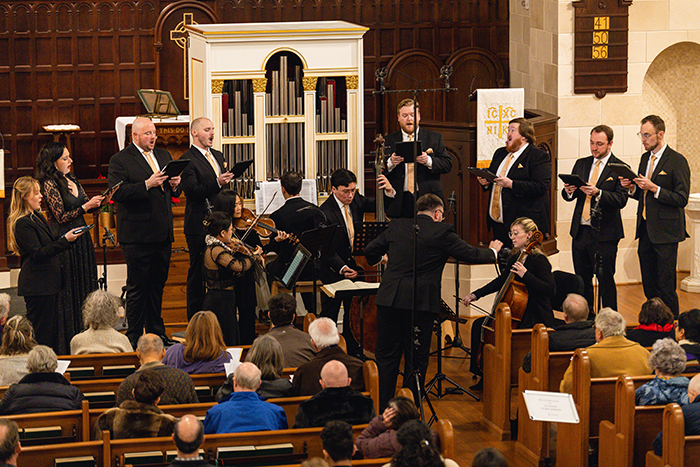
7 ⁄7
Harmonia Stellarum performing sacred masterworks by Mozart. Photo by Carlo Resti Ruano.
Just as HSH welcomed the first Italian Renaissance style organ to Texas and made it the cornerstone of its programming last season, the Stein fortepiano will play a big part in a pair of this season’s concerts. Aschauer will be the soloist, backed up by his merry band, in The land of the clavier… (Jan. 11, 2026), in a program featuring keyboard concertos from Mozart’s Vienna. He notes that playing the Stein “requires a highly coordinated sensitivity.” He’ll probably use both actions “just for the fun of it.”
The second concert will be the most intimate of the season. Per Violino e Fortepiano (Feb. 15, 2026) spotlights powerhouse Baroque violinist Manami Mizumoto and Aschauer at the keyboard in a program of sonatas and variations. One of the composers Mizumoto and Aschauer will be introducing to the audience is Josef Antonín Štěpán (1726-1797), a highly respected harpsichordist in Vienna and piano teacher to Marie Antoinette.
“He essentially had the job that Mozart would have wanted,” explains Aschauer, “namely being the piano guy at the Imperial Court in Vienna.” The duo plans to record an album of Štěpán’s sonatas and variations. “I can’t believe there are no modern editions and recordings of some of these works,” exclaims Aschauer. “They are the kind of pieces a violinist would want to play, with a real violin part, instead of what was typical at the time with the violin playing a less prominent role. Both parts are difficult.”
The jubilant opening recalls the spirit of Handel, with all the pomp and brilliance in its dotted rhythms and C Major tonality. Schubert conveys the sense of excitement and danger, with shimmering swells in the piano and shifting harmonies. The vocal writing evokes all the power and emotion of the unfolding drama.
“He really explores the landscape in its depths,” explains Aschauer. “These pieces are interesting because they don’t conform to any genre norms, because there’s really no such genre.” They were also not mass market products, but rather published for in-home music making. “Schubert is just not thinkable outside the whole Biedermeier environment,” says Aschauer, when creativity flourished in the private salons of the newly affluent middle class.
The story of Venetian opera master Francesco Cavalli’s Requiem sounds too implausible to be true, but it is well-documented that the composer wrote the piece for himself and gave specific instructions for it to be performed in his memory every six months in perpetuity, once in San Marco where he was the maestro di cappella, and once in San Lorenzo, where he was buried. “Cavalli died a very wealthy man,” explains Aschauer, “He absolutely dominated the opera scene in Venice, but he was rich not because he wrote all those operas, but because of his second wife’s money. Therefore he had disposable money to put into this idea. He even left an amount for the sheet music to be recopied as needed.”
Unlike his lavish and dramatic operas, the Requiem, serene and exquisite, is mostly written in the stile antico, recalling the vocal contrapuntal style of the late 16th century and early 17th century. “Until it is not,” says Aschauer. “He just can’t hide that he is an opera composer. The exuberance shows through the cracks, particularly in the Dies Irae. It is all done within the framework of the stile antico. There is nothing quite like it.” Aschauer has found references to Cavalli’s Requiem in early music history books of the 19th century where the work is described as “the most beautiful Requiem of the 17th century.” It will be a most fitting offering for All Souls’ Day.
Aschauer explains that German Lutheran composers of the 17th century took advantage of a great opportunity to reinvent church music. “Because they were not bound by the traditional confines of Catholic sacred music, and the relatively new ideas of monody and theatrical music were in the vernacular, now everything is on the table. So these composers are in an amazing position. Not only did they have the freedom to invent whatever they want, they were given all the tools as well.”
Much of this music has never been performed. “In German we call them the small masters and we’ve always viewed them in the shadow of the big masters, but I like to look at them in their own right.” It starts with Aschauer transcribing old manuscripts from discoveries in library archives and collections. Right now he is transcribing pieces by Johann Kaspar Horn, a Dresden composer connected to Schütz. “Sometimes it is only printed in parts and I have to create a score.” It is painstaking work, but Aschauer relishes the process. “This piece has not been heard in 300 years, and it’s rising in front of me from the ashes.”
For the Lenten season, HSH will present Antonio Bertali’s Il Pentimento (1661), a completely unique allegory from the imperial court of Vienna. The Viennese developed a particular type of Lenten oratorio called the Sepolcri. “They literally built a replica of Jesus’s tomb inside the church, but with all the elaborate Baroque ornamentations,” explains Aschauer.
Il Pentimento was written for the 1661 celebration of the Holy Week, and would have been performed semi-staged around the sepulchre. Aschauer will not be building a sepulchre for this performance, but the music will be duly magnificent, unfolding through poignant dialogues between allegorical figures, Mary Magdalene, and the Virgin Mary, set against a richly-hued palette of viols, cornettos, and continuo.
“These are Italian composers, but they knew the emperor was a music aficionado. The 17th century Imperial Court is incredibly interesting because you have essentially four consecutive emperors who were also composers.” In fact, the reason some of this music survived is because the emperor personally collected them. Emperor Leopold I kept musical scores, bound in white vellum, in his bedroom. That collection, the bibliotheca cubicularis (Bedroom Library) is now in the Austrian National Library.
All the research and scholarship are just notes on paper without the interpretive expertise and artistry of HSH musicians. As an ensemble, they bring the music to expressive life, recreating an authentic sound world out of pages in dusty archives and history books. Historically informed performance is not just about using period instruments, studying treatises, and reading old manuscripts for their own sake. When the music rises out of the ashes and envelops the audience in sheer wonder, all the behind-the-scenes work is rewarded. As Aschauer says, “there is nothing we wouldn’t do to bring you that experience.”
—SHERRY CHENG



